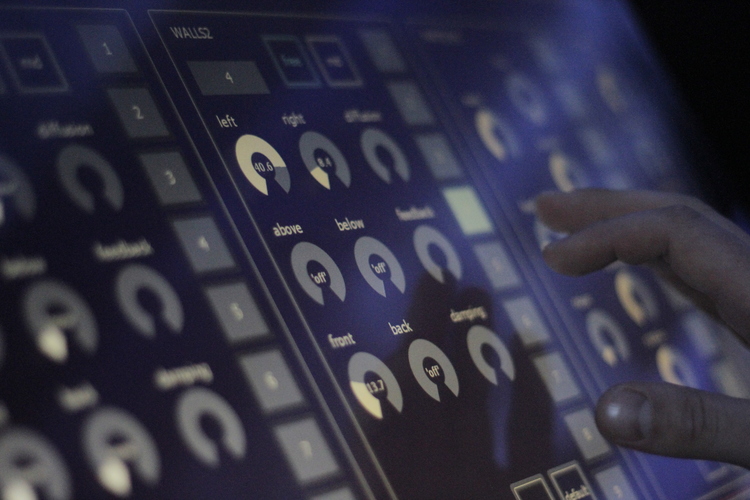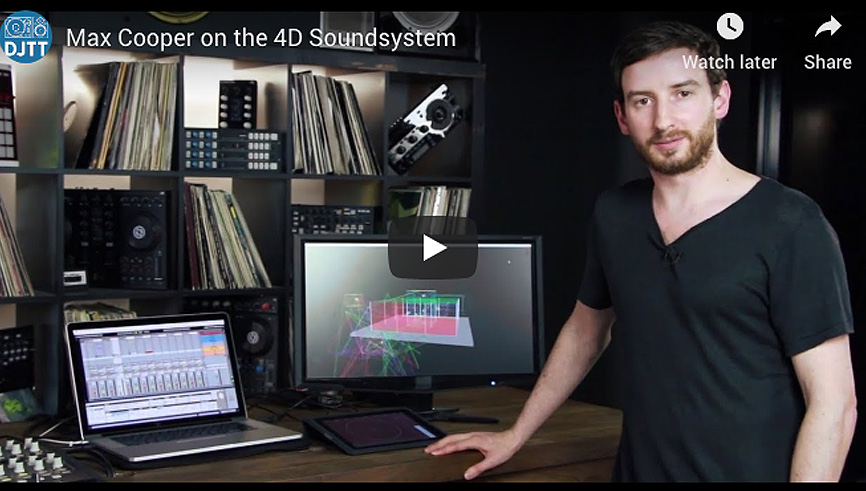Sound Holograms (2014)
Salvador Breed
Written by 4DSOUND’s co-founder and creative developer Salvador Breed, ‘Sound Holograms’ captures the reflections of three unique artists after experiencing 4DSOUND: architect and scientist Philip Beesley, sound designer and composer Max Cooper and web and visual artist Geoffrey Lillemon.
authors:
Salvador Breed, Philip Beesley, Max Cooper
category:
Essay
date:
January 2014
source:
This essay originally appeared in A Magazine No 13
Salvador Breed, Philip Beesley, Max Cooper
category:
Essay
date:
January 2014
source:
This essay originally appeared in A Magazine No 13
Imagine listening to a symphony - not seated in the audience, but walking amongst the orchestra as it plays. In passing through, you hear violins on your left. Directly in front of you, the flutes are playing. You stand still and close your eyes as the melodies flow from the instruments. Suddenly, from the right hand corner, the voice of a soprano gradually appears, drawing closer until she’s right beside you. It seems to pass through you before disappearing. Then out of nowhere, drops of water start to crash on several spots on the theatre floor. It has started to rain. Slowly the orchestra pirouettes around you, while lifting itself up in the air.

4DSOUND is a system that has the ability to project moving “sound holograms” within a space; sound that you can not only listen to, but that also has the ability to move around and through you. It instigates an active role for the listener, who hereby becomes the co-composer of the piece itself, as where one is standing, or how one moves through a space, essentially influences the experience. With this, the music and the presence of the listener in the space become a physical experience for the senses. Often people who experience this for the first time speak of it as it being a ‘trip’; the music becomes responsive to the listener, creating an inclusive world of sounds within which one can freely move.
4DSOUND originates from the need to transform a suggestive space within music to the level of actual experience. Six years of research into the physical, physiological and psychological nature of sound in space has led to new ways of synthesising these elements into a physical experience. While the technology is complex, the experience and performance are intuitively linked to the natural world. For example electronic music, which previously only existed in a suggestive space, may now be sculpted within an actual space; it allows kick drums to bounce through the room, synthesizer riffs to spiral up and down and hi-hats to shoot right by the listener, like cars on a highway.
![]() The three-dimensional visualiser artists use to develop and monitor their compositions
The three-dimensional visualiser artists use to develop and monitor their compositions
![]()
Since producers are forced to compose a three-dimensional surrounding, their musical paradigm changes entirely, in that each sound needs its own position, dimensions and movement. With this new approach, the music is then mixed using a three-dimensional graphic interface. Working within the visual representation of space allows the composer to develop ideas and track each moving sound. Although now confined to computer screens, this technology will soon be adapted to virtual reality opticals. Physical space is played like an instrument – opening doors to new, undiscovered experiences.
Max Cooper:
4DSOUND originates from the need to transform a suggestive space within music to the level of actual experience. Six years of research into the physical, physiological and psychological nature of sound in space has led to new ways of synthesising these elements into a physical experience. While the technology is complex, the experience and performance are intuitively linked to the natural world. For example electronic music, which previously only existed in a suggestive space, may now be sculpted within an actual space; it allows kick drums to bounce through the room, synthesizer riffs to spiral up and down and hi-hats to shoot right by the listener, like cars on a highway.
 The three-dimensional visualiser artists use to develop and monitor their compositions
The three-dimensional visualiser artists use to develop and monitor their compositions

Since producers are forced to compose a three-dimensional surrounding, their musical paradigm changes entirely, in that each sound needs its own position, dimensions and movement. With this new approach, the music is then mixed using a three-dimensional graphic interface. Working within the visual representation of space allows the composer to develop ideas and track each moving sound. Although now confined to computer screens, this technology will soon be adapted to virtual reality opticals. Physical space is played like an instrument – opening doors to new, undiscovered experiences.
Philip Beesley:
“From very early twentieth-century experimental sound-compositions through to the full-blooded electronic environments of the 1950’s and 60’s, a kind of Holy Grail quest has marked the pursuit of a fully controllable, immersive acoustic environment. There have been numerous technical innovations over these decades, with increasingly powerful results. Myself, I’ll never forget the hair-raising experience of standing in Buffalo Rich Stadium in 1973 amidst an enormous quadrophonic system positioned around the rim of the arena with Emerson, Lake and Palmer operating a joystick that pushed a blistering wall of sound all around us, making the entire crowd lean with the movement of the sound as if in a hurricane.
But I can honestly say I’ve never had such an acutely emotional, astonished reaction to a sound environment as I had just a little while ago, in an industrial space on the harbour in Amsterdam. A hollow stage, marked by a grove of meshwork columns stretching far above and around me, held custom speakers suspended near the floor, beside my body, just above my head, and far above. Underneath my feet lay subsonic speakers within the stage floor.
This hovering array had the effect of puncturing the black box of the full stage, transforming it into a transparent continuum as delicate sound began to wash through the space, moved by custom controls. Whispers hung in the air, moving close to me, wrapping close around and then moving far away into the distance. Elongated tones clustered in concentrated masses that focused into distinct surfaces stretching through the space, inviting me to move along them and search out their limits. Underpinned by the lurking sounds of an earth-based beating below my feet, an exquisitely intimate series of voices moved disarmingly close, surrounding me and clustering right around my head and shoulders. In the distance, far above, the sound of rushing air pulled me across to the very limits of the horizon, radically far from the physical limits of the sound stage.
These sensations, graphically etched within tangible space, might be striking enough, however I am not sure I will be able to adequately describe the emotional reactions that this spatial immersion created for me as well. When the sound was distant, my body instinctively flexed and became poised, searching the distance for the source. When it came very close, a curious wave of full-body contact responded as well, my elbows and knees echoing with tingling from the close contact. The intensity of those reactions was unnerving. Was it because I was amidst friends, feeling tremendous pleasure at their prodigious technical achievements and poetic sensitivity? Those things might be true, but I do think something more was at work as well, rooted in the essential ‘embodied’ experience that this system offers. If creative sound can come from the surrounding world rather than only from a focused, tightly defined source defined by individual authors, then I think our conceptions of art might change in fundamental ways. The detailed and subtle space created by the 4DSound system implies a very different picture of the world, where voices and presences can be everywhere.“
— Philip Beesley, Architect
Max Cooper:
“Music has traditionally been about our perception of the frequencies of sound waves. Those frequencies too fast for us to separate are perceived as pitch, yielding melody and harmony, and the slower frequencies of repeating elements yield rhythm. Then there are dynamics, timbre and texture, providing the development and character of a piece of music.
The 4D Sound system literally adds an extra dimension to music categorisation, with the addition of space to this list. How sounds are placed, sized, shaped and moved within the fully 3-dimensional environment of the 4D sound rig has a huge effect on how a piece of music is perceived. An individual can hear different rhythmical interactions and different atmospheres depending on their position and which direction they are facing, and they can explore each piece of music physically. This opens a whole new world of composition possibilities, as well as a lot of challenges as how best to create music in this new format.
I approached the project by choosing appropriate tracks and then devising an individual spatial format for each track that would complement it's basic musical concept, including moments with single clear sounds to demonstrate clear paths; implosions and explosions, positions and other spatial effects. Imagining how I would want to hear each piece of music as a living physical entity, existing in real space and time, removes the abstraction of an emotive and subconscious response to music, making it tangible - something that you can walk inside, explore and discover new things within. Instead of relying on unexpected twists and turns in a musical arrangement, I can hide them in parts of the room, or allow them to fly around every so often to reach each listener.
The whole approach to arrangement can be turned on it's head, as each listener creates a unique arrangement based on their path through the room.“
— Max Cooper, Producer, UK4DSOUND originates from the need to transform a suggestive space within music to the level of actual experience. 10 years of research into the physical, physiological and psychological nature of sound in space has led to new ways of synthesising these elements into a physical experience. While the technology is complex, the experience and performance are intuitively linked to the natural world. For example electronic music, which previously only existed in a suggestive space, may now be sculpted within an actual space; it allows kick drums to bounce through the room, synthesizer riffs to spiral up and down and hi-hats to shoot right by the listener, like cars on a highway.
Related:
 ‘Interacting with 4DSOUND’ (2014)
‘Interacting with 4DSOUND’ (2014)  ‘Max Cooper on the 4DSOUND System’ (2013)
‘Max Cooper on the 4DSOUND System’ (2013)